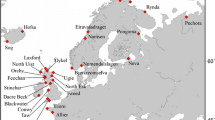Abstract
Glutamate-oxaloacetate transaminase (GOT; EC 2.6.1.1) occurs as two electrophoretically distinguishable isozymes in the copepod Tigriopus californicus. The slower-migrating form, referred to as GOT2, is shown to be associated with the mitochondrial cell fraction. GOT2 phenotypes are inherited in typical Mendelian fashion, indicating that they are encoded by a nuclear gene. Allelic frequencies for electrophoretic variants of the two Got loci in 12 California populations of T. californicus show a sharp differentiation of local populations. Linkage studies demonstrated that Got-2 is linked to Got-1; a map of four loci in linkage group I is presented.
Similar content being viewed by others
References
Ar-rushdi, A. H. (1963). The cytology of achiasmatic meiosis in the female Tigriopus (Copepoda). Chromosoma 13526.
Burton, R. S. (1983). Protein polymorphisms and genetic differentiation of marine invertebrate populations. Mar. Biol. Lett. 4193.
Burton, R. S., and Feldman, M. W. (1981). Population genetics of Tigriopus californicus. II. Differentiation among neighboring populations. Evolution 351192.
Burton, R. S., and Feldman, M. W. (1983). Physiological effects of an allozyme polymorphism: Glutamate-pyruvate transmainase and response to hyperosmotic stress in the copepod Tigriopus californicus. Biochem. Genet. 21239.
Burton, R. S., Feldman, M. W., and Curtsinger, J. W. (1979). Population genetics of Tigriopus californicus (Copepoda: Harpacticoida). I. Population structure along the central California coast. Mar. Ecol. Prog. Ser. 129.
Burton, R. S., Feldman, M. W., and Swisher, S. G. (1981). Linkage relationships among five enzyme-coding gene loci in the copepod Tigriopus californicus: Genetic confirmation of achiasmatic meiosis. Biochem. Genet. 191237.
Claude, A. (1946). Fractionation of mammalian liver cells by differential centrifugation. J. Exp. Med. 8451.
DeLorenzo, R. J., and Ruddle, F. H. (1970). Glutamate oxaloacetate transaminase (GOT) genetics in Mus musculu: Linkage, polymorphism, and phenotypes of the GOT-2 and GOT-1 loci. Biochem. Genet. 4259.
Grell, E. H. (1976). Genetic analysis of aspartate aminotransferase isozymes from hybrids between Drosophila melanogaster and Drosophila simulans and mutagen-induced isozyme variants. Genetics 83753.
Harris, H., and Hopkinson, D. A. (1976). Handbook of Enzyme Electrophoresis in Human Genetics North-Holland, Amsterdam.
Hedgecock, D., Tracey, M. L., and Nelson, K. (1982). Genetics. In Abele, L. G. (ed.), The Biology of Crustacea, Vol. 2 Academic Press, New York, pp. 283–403.
Tolley, E., van Heyningen, V., Brown, R., Bobrow, M., and Craig, I. W. (1980). Assignment to chromosome 16 of a gene necessary for the expression of human mitochondrial GOT (aspartate aminotransferase) (EC 2.6.1.1). Biochem. Genet. 18947.
Author information
Authors and Affiliations
Additional information
This work was supported by NSF grant DEB-8207000 to R.S.B. and an NIH traineeship in Genetics to M.M.D.
Rights and permissions
About this article
Cite this article
Dill, M.M., Burton, R.S. Genetics of mitochondrial glutamate-oxaloacetate transaminase (GOT-2) in Tigriopus californicus . Biochem Genet 22, 339–347 (1984). https://doi.org/10.1007/BF00484232
Received:
Revised:
Issue Date:
DOI: https://doi.org/10.1007/BF00484232




